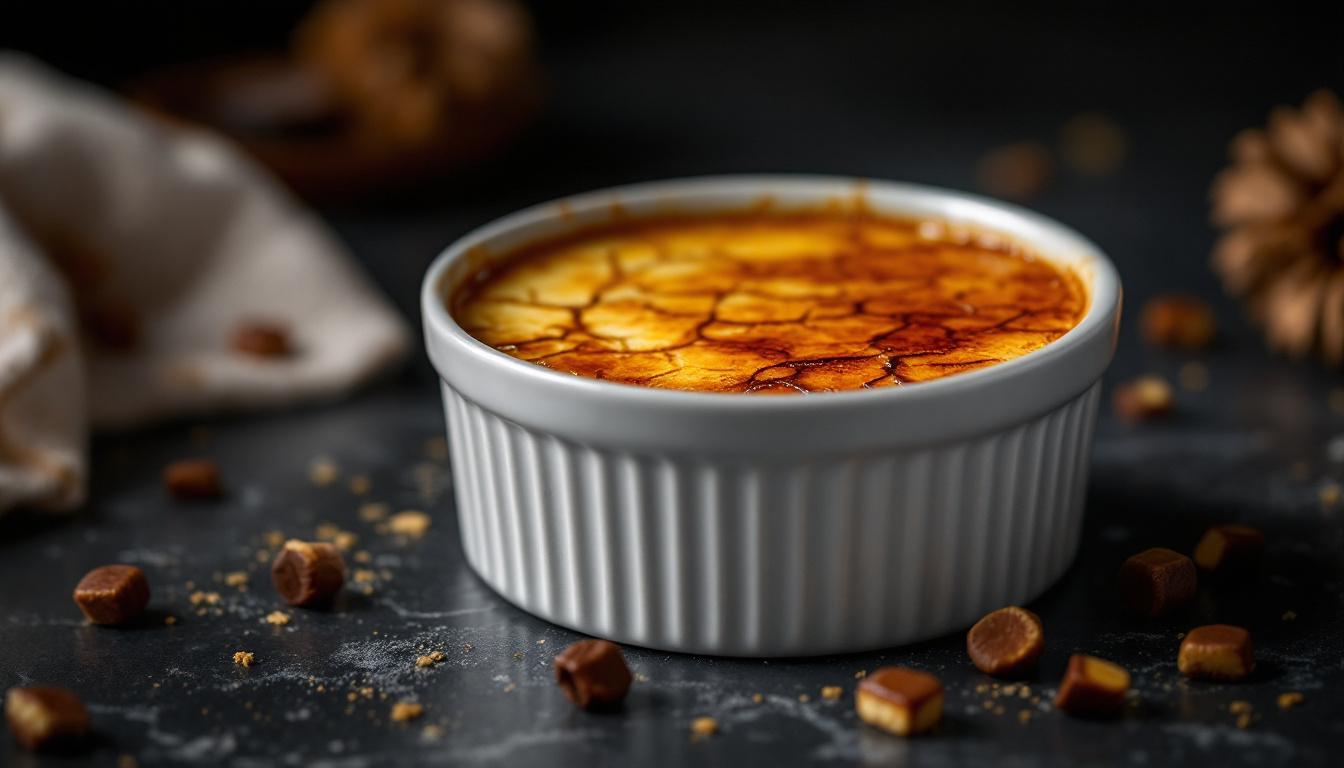I still remember the first time I made a proper crème brûlée in Paris. My mentor, a stern Frenchman with 40 years of experience, watched as I nervously torched the sugar top. “Non, non! Plus lentement!” he barked. That day, I learned that perfect crème brûlée isn’t about fancy ingredients or complicated techniques—it’s about respecting time-honored methods and understanding the subtle dance between temperature and texture. This classic French dessert may seem intimidating, but I promise: master these fundamentals, and you’ll create a dessert worthy of the finest Parisian bistro.
The Story
Crème brûlée literally means “burnt cream” in French, but there’s nothing burnt about it when done properly. Dating back to the 17th century, this custard with its crackling caramelized top has remained relatively unchanged for good reason. While working in Provence, I discovered that the best versions aren’t fussy or overworked—they’re simple celebrations of cream, vanilla, and that magical textural contrast between cold, silky custard and warm, shattered sugar glass.
Ingredients Spotlight
• 2 cups (500ml) heavy cream (minimum 36% fat)
• 1 whole vanilla bean, split and scraped (or 1½ tsp pure vanilla extract)
• 6 large egg yolks (room temperature)
• ¼ cup (50g) granulated sugar, plus 2 tbsp for topping
• Pinch of fine sea salt
The fat content in your cream matters tremendously here—anything less than 36% will produce a less luxurious texture. And while vanilla extract works, a real bean creates those beautiful flecks that announce “this was made with care.” When I can’t find vanilla beans, I sometimes infuse the cream overnight with a cinnamon stick and orange peel—a trick I learned at a small bistro in Lyon.
Step-by-Step Guide
1. Preheat your oven to 325°F (160°C). Arrange four 6-ounce ramekins in a baking dish with high sides.
2. In a medium saucepan, combine cream and vanilla bean (pod and seeds). Heat until it just begins to simmer (tiny bubbles at the edges), then remove from heat and let steep for 10 minutes.
3. In a bowl, whisk egg yolks, sugar, and salt until pale yellow and slightly thickened, about 2 minutes.
4. Remove vanilla pod from cream. Very slowly pour about ½ cup of warm cream into egg mixture while whisking constantly (this tempers the eggs).
5. Gradually add remaining cream, whisking continuously.
6. Strain mixture through a fine-mesh sieve into a clean bowl or measuring cup with a pour spout.
7. Divide custard evenly among ramekins. Pour hot water into the baking dish until it reaches halfway up the sides of the ramekins.
8. Bake for 25-30 minutes, until edges are set but centers still jiggle slightly when shaken.
9. Remove from water bath and cool completely. Refrigerate for at least 2 hours (preferably overnight).
10. Just before serving, sprinkle 1½ teaspoons sugar evenly over each custard. Caramelize with a kitchen torch using circular motions, or place under a very hot broiler for 2-3 minutes, watching closely.
Expert Techniques
The key to perfect crème brûlée lies in the baking. You want to pull it from the oven when it still has what I call “the sacred wobble”—firm around the edges but with a gentle jiggle in the center. For silky texture, strain your custard twice—once after infusing the cream and again after combining with eggs. And here’s my non-negotiable rule: always use boiling water for your water bath, never cold. This kickstarts the cooking process and ensures even heat distribution.
Chef’s Note: The sound of cracking into a properly caramelized sugar top should be sharp and distinct. If it’s soft or the sugar is still granular in spots, your torch technique needs refining. Move in small circles about 2-3 inches above the surface rather than holding the flame in one spot.
When caramelizing the sugar top, multiple thin layers work better than one thick layer. I apply a thin coat, torch it, then add another light sprinkle and torch again for the perfect amber depth. This technique is something I picked up from a renowned chocolatier who approaches all desserts with this layering philosophy.
Presentation & Pairing Ideas
Crème brûlée needs no garnish—its beauty lies in simplicity. Serve it in white ramekins to showcase the contrast between the golden top and creamy center. For a memorable dessert course, pair with a small glass of Sauternes or late-harvest Gewürztraminer. During summer, I love offering a side of fresh berries (never on top—that would soften the caramel!). In winter, a few classic French madeleines make the perfect accompaniment.
For a seasonal twist, try infusing your cream with lavender in spring, fresh mint in summer, or star anise in fall. Those with dietary concerns can substitute half the cream with coconut cream for a slightly different but still luxurious result.
Remember this as you create your crème brûlée: don’t rush perfection. This dessert isn’t meant to be quick or casual—it’s a deliberate exercise in patience that rewards you with one of the most sublime texture experiences in all of dessert-making. Like the best French techniques from tarts to beignets to elaborate croquembouche, it’s the respect for process that elevates the simple to the extraordinary. Now go forth and crack that sugar with confidence! 🔥✨
